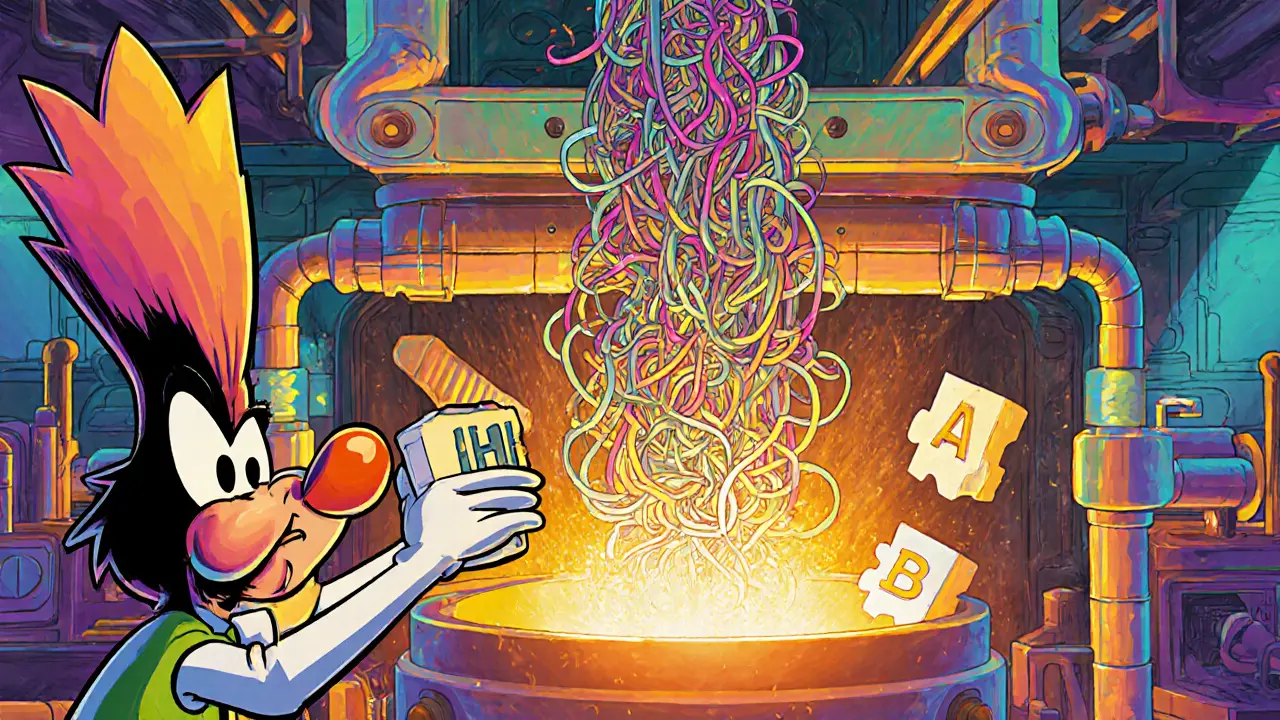
Blockchain Algorithm Selector
Select your project's priorities to get tailored recommendations
Recommended Hash Algorithms
Recommended Algorithm
Alternative Options
Algorithm Comparison
Security
Performance
Decentralization
Future-Proofing
Implementation Recommendation
Key Takeaway: For your project with ,
When you hear "crypto," the first thing that comes to mind is usually coins, wallets, and wild price swings. What actually keeps those digital ledgers honest is a set of hash algorithms that turn any data into a fixed‑size string no one can reverse or tamper with. Below we break down the most common algorithms, why they matter, and how to pick the right one for your project.
Quick Takeaways
- SHA‑256 powers Bitcoin and the largest share of market‑cap‑weighted crypto today.
- Keccak‑256 (Ethereum’s version of SHA‑3) adds flexibility for smart‑contract platforms.
- BLAKE2b is the speed champion, ideal for high‑throughput networks like Nano.
- Memory‑hard algorithms such as Equihash and Scrypt aim to curb ASIC dominance.
- Future designs should stay algorithm‑agile to survive quantum‑computing threats.
What Is a Hash Algorithm?
Hash algorithms are cryptographic functions that convert input data of any length into a fixed‑size output, called a hash. The output is deterministic (same input always yields the same hash), appears random, and is practically impossible to reverse. In a blockchain each block’s hash links it to the previous block, forming an immutable chain.

Major Crypto‑Focused Hash Algorithms
Here are the six algorithms you’ll see most often in public blockchains.
- SHA‑256 a 256‑bit member of the SHA‑2 family, used by Bitcoin and many other coins
- RIPEMD‑160 a 160‑bit hash often paired with SHA‑256 for Bitcoin address generation
- Keccak‑256 Ethereum’s variant of SHA‑3 that uses a sponge construction and a unique padding rule
- BLAKE2b a fast, secure 512‑bit hash designed to outperform SHA‑2 on modern CPUs
- Equihash a memory‑hard algorithm that forces miners to use large RAM, aiming to resist ASICs
- Scrypt another memory‑hard scheme used by Litecoin, requiring significant memory bandwidth
Technical Specs at a Glance
| Algorithm | Output size | Typical use | Speed (ns per hash) | ASIC / Memory‑hard |
|---|---|---|---|---|
| SHA‑256 | 256bits (64hex chars) | Bitcoin proof‑of‑work, many altcoins | ≈700 | ASIC‑friendly |
| RIPEMD‑160 | 160bits (40hex chars) | Bitcoin address hashing (after SHA‑256) | ≈1,200 | ASIC‑friendly |
| Keccak‑256 | 256bits | Ethereum smart‑contract platform | ≈1,000 | ASIC‑friendly (but higher latency than SHA‑256) |
| BLAKE2b | 512bits | Nano high‑throughput payments | ≈400 | ASIC‑resistant (CPU‑optimized) |
| Equihash | Variable (commonly 200‑bits) | Zcash privacy mining | 5,000-10,000 | Memory‑hard (≈140MB RAM) |
| Scrypt | 256bits | Litecoin proof‑of‑work | ≈4,000 | Memory‑hard (≈32× more memory than SHA‑256) |
Pros, Cons, and Ideal Use Cases
Each algorithm shines in a different scenario.
- SHA‑256: rock‑solid security, huge ecosystem, but dominated by ASICs. Best for store‑of‑value chains where decentralization of mining power is less critical.
- Keccak‑256: built for flexibility, supports complex smart‑contract logic, yet still fast enough for everyday transactions. Ideal for platforms that need programmable assets.
- BLAKE2b: blazingly fast on CPUs, low energy use, but fewer ASIC miners mean less profit‑driven centralization. Perfect for micro‑payment networks like Nano.
- Equihash: memory‑hard design deters cheap ASICs, but recent ASICs have narrowed the gap. Works for privacy‑focused coins that want to keep mining accessible.
- Scrypt: similar to Equihash in memory demand, though older and less efficient than newer memory‑hard schemes. Still popular for legacy coins like Litecoin.
- RIPEMD‑160: primarily a secondary hash, adds a layer of protection to Bitcoin addresses but slows down high‑throughput pipelines.

Choosing the Right Algorithm for Your Project
- Define security needs. If you need battle‑tested resilience and can tolerate ASIC mining, SHA‑256 is safe.
- Consider performance goals. For sub‑second confirmation, BLAKE2b or Keccak‑256 are better choices.
- Evaluate hardware environment. If you expect many small miners, pick a memory‑hard algorithm (Equihash, Scrypt) to level the playing field.
- Plan for future upgrades. Build in algorithm‑agility: store hashes with a version tag so you can switch if quantum‑resistance becomes urgent.
- Match ecosystem expectations. Existing communities often standardize on one algorithm; deviating can hurt adoption.
Future Trends and Quantum Concerns
Quantum computers threaten any hash function that can be inverted faster than classical brute force. Researchers estimate practical attacks on SHA‑256 could appear within 10‑15 years. Because of that, many new blockchains are already eyeing SHA‑3 variants, which offer better resistance to length‑extension attacks and have a more flexible sponge design.
By 2027, analysts predict roughly one‑third of fresh blockchain projects will default to SHA‑3‑based hashes. Meanwhile, NIST’s post‑quantum standards (expected 2024) will likely introduce hash‑oriented candidates, giving developers a clear migration path.
In the meantime, keeping your code modular-so you can swap out the hash function without a hard fork-will save headaches when the next quantum‑resistant algorithm lands.
Frequently Asked Questions
Why does Bitcoin use SHA‑256 instead of a newer algorithm?
SHA‑256 was chosen by Satoshi Nakamoto because it was well‑studied, publicly available, and efficiently implementable on CPUs at the time. Its long‑term track record gives developers confidence, even though newer algorithms may offer better performance or ASIC resistance.
Can I mix multiple hash algorithms in a single blockchain?
Yes. Some projects use a primary PoW hash (like SHA‑256) and a secondary hash (like RIPEMD‑160) for address generation or transaction IDs. Mixing adds complexity, so clear documentation and library support are essential.
What’s the biggest downside of memory‑hard algorithms?
They demand a lot of RAM, which can hit low‑end devices and raise energy use. Also, once ASICs catch up, the intended resistance can disappear, as seen with recent Equihash miners.
Is BLAKE2b safe for financial applications?
BLAKE2b has been peer‑reviewed, shows no practical collisions, and is faster than SHA‑2 on standard CPUs, making it a solid choice for high‑throughput payment systems.
When should a new blockchain consider switching hash algorithms?
If the current algorithm faces centralization pressure (ASIC dominance) or emerging quantum threats, planning a fork with a versioned hash tag lets you transition without breaking existing data.

Cynthia Chiang
October 15, 2025 AT 09:15I think this guide does a great job at breaking down the core hash functions. It's important to remember that each algorith has its own sweet spot, and picking the right one can save you a lot of headaches later. If you’re still unsure, try running a few test nets with different hashes – you’ll learn a lot from the results.
Hari Chamlagai
October 19, 2025 AT 01:15SHA‑256 is the gold standard for security, but it is also the poster child for ASIC centralization. The fact that billions of dollars have been poured into ASIC farms proves that the algorithm is both robust and vulnerable to hardware optimization. Keccak‑256, while marketed as a SHA‑3 cousin, introduces a sponge construction that offers greater flexibility for smart‑contract platforms. However, its performance is still bound by the underlying hardware and can be hammered by specialized miners. BLAKE2b shines because it is CPU‑friendly, delivering lower latency and energy consumption, which makes it ideal for high‑throughput networks. Its design deliberately avoids the memory‑hardness that protects against ASICs, so it trades off decentralization for speed. Equihash was created to level the playing field by demanding large RAM, but recent ASIC developments have started to erode that advantage. Scrypt follows a similar memory‑hard philosophy, yet its parameters have been tuned over the years, resulting in diminishing returns for newer hardware. RIPEMD‑160 serves primarily as a secondary hash, adding an extra layer of security to Bitcoin addresses without significantly impacting performance. When choosing an algorithm, you must weigh the trade‑off between security, speed, and decentralization. A project focused on privacy may benefit from memory‑hard functions despite their slower speed. Conversely, a payment system that values transaction velocity should consider BLAKE2b or an optimized Keccak variant. Future‑proofing also demands that you design your protocol to be algorithm‑agile, allowing swaps as quantum threats emerge. Ignoring this flexibility can lead to costly hard forks down the line. Ultimately, there is no one‑size‑fits‑all solution; the best choice aligns with your project's priority matrix.
Jim Greene
October 22, 2025 AT 17:15Great breakdown, Hari! 👍 I’d add that for developers experimenting with new chains, starting with a well‑documented hash like BLAKE2b can speed up prototyping, especially when you’re running on commodity hardware. If you need cross‑compatibility with existing ecosystems, Keccak‑256 gives you that Ethereum‑style flexibility without a huge performance penalty. 🌟
Della Amalya
October 26, 2025 AT 09:15Imagine a world where every transaction races through the network like a comet blazing across the night sky-that’s the promise of BLAKE2b in a high‑throughput environment. Yet the drama doesn’t stop there; the shadows of ASIC dominance loom over SHA‑256, threatening to eclipse the very decentralization we cherish. Choosing the right hash is a delicate dance between speed and security, a ballet where each step decides the future of our digital economies.
Teagan Beck
October 30, 2025 AT 01:15Honestly, the article made the whole hash thing way easier to grasp.
Kim Evans
November 2, 2025 AT 17:15Glad it helped! 😊 If you ever need a quick cheat sheet on which algorithm fits your project, just shout.
Isabelle Graf
November 6, 2025 AT 09:15Too much fluff, not enough actionable guidance.
Millsaps Crista
November 10, 2025 AT 01:15Hold up, Isabelle-while brevity is fine, the details here actually empower developers to make informed choices, and ignoring that does a disservice to newcomers.
Shane Lunan
November 13, 2025 AT 17:15hashes are the backbone of blockchain security.
Jeff Moric
November 17, 2025 AT 09:15Exactly, Shane. They provide the immutable link between blocks, ensuring tamper‑evidence across the ledger.